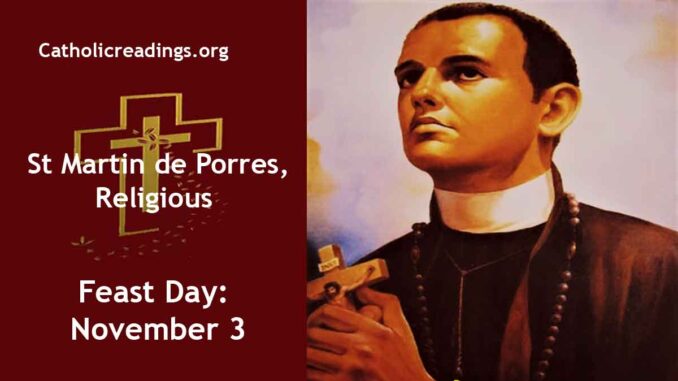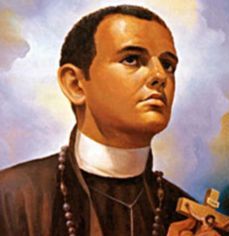St Martin de Porres Velázquez was a Dominican lay brother.
He was born on December 9 1579 in Lima, Peru.
He died on November 3 1639 at the age of 60 in Lima.
We celebrate his feast day on November 3 every year in the Catholic Church.
St. Martin de Porres, Religious is the Patron Saint of
- Black people
- Race relations
- Mixed-race people
- Television
- State schools
- Public schools
- Public health
- Public education
- Poor people
- Social justice
- Peruvian Naval Aviators
- Peru
- Mexico
- Lottery winners
- Lottery
- Innkeepers
- Hair stylists
- Diocese of Biloxi, Mississippi
| St Martin de Porres, Religious Biography | |
|---|---|
 |
|
| Date of Birth | December 9 1579 |
| Place of Birth | Lima, Peru in South America |
| Profession | Lay brother of the Dominican Order |
| Place of Work | Lima, Peru |
| Date of Death | November 3 1639 (aged 60) |
| Place of Death | Lima, Peru |
| Feast Day | November 3 |
| Beatification | By Pope Gregory XVI in 1837 |
| Canonization | By Pope John XXIII on May 6, 1962 |
| Patron Saint of |
|
St Martin de Porres Life History
St Martin de Porres was an illegitimate son of a freed African Slave called Ana Velázquez and a Spanish nobleman called Don Juan de Porras y de la Peña. He had a sister called Juana de Porres who was two years younger than him.
The Spanish nobleman abandoned his family after Martin’s sister was born and their mother supported her family by doing laundry work.
Martin’s family grew up in poverty. He went to a primary school for two years and thereafter went to learn medical arts at a barber and surgeon establishment.
During this time he spent many hours in prayer and this passion increased over time. He practised his trade as a healer and a barber with passion.
St Martin de Porres was barred from becoming a full member of a religious order by the prevailing Peruvian law because he was of African descent.
However, the only way to become a Dominican member was to work as a volunteer, doing small tasks in the monastery and in exchange, be allowed to wear the Dominican habit and also live with them.
He was, therefore, accepted at the Dominican Convent of the Rosary in Lima at the age of 15 as a servant and was later promoted to be an officer in charge of distributing alms to the poor.
While still in the community, St Martin de Porres continued practising barbering and healing and severally, it was reported that he had performed miraculous cures.
St Martin de Porres was very dedicated in his work for 8 years such that his prior at the monastery, Juan de Lorenzana, decided to overlook the law and permit him to take his vows as a member of the Third Order of Saint Dominic.
Not all the members of the monastery were happy with the admission of St Martin to the Order. He was mocked for being illegitimate and of African slaves descent and some called him a “mulatto dog”.
He did not take offence at this derogatory name and at one time when the monastery was in debt, he volunteered to be sold as a slave saying, “I am only a poor mulatto, sell me.”
In 1603, at the age of 24 years, Martin professed his religious vows as a Dominican lay brother. He continued with his deep devotion to the Blessed Sacrament.
One night when he was praying, the wood around the altar caught fire and he continued praying unaware that there was fire around him.
At the age of 34, St Martin de Porres was made the person in charge of the Monastery’s infirmary, a designation he held for the rest of his life.
He took care of the sick with passion and many a time miracles were attributed to him. He would heal a sick person with only a glass of water.
He did not discriminate against anyone. He cared with the same measure whether one was a Spanish noble or a black slave, a beggar or rich.
One time, Martin found a dirty beggar covered with sores and wounds, and out of pity and compassion, he carried him to his own bed for care.
When one of the Dominican companions rebuked him, Martin replied, “Compassion is preferable to cleanliness, my dear Brother.”
At one time, an epidemic struck the City of Lima and many of the novices became sick in the monastery. They were quarantined and locked in a separate section of the monastery so as not to contract the disease to the professed members.
It is said that St Martin de Porres would miraculously pass through the locked doors and administer to the sick novices.
St Martin continued to bring in more patients to the monastery but his superior forbade him to do so because those many patients could not be contained there and also posed a danger to the community.
Juana de Porres, his sister, offered her house to hold those extra patients that the monastery could not. But one day Martin found a wounded man on the streets bleeding to death.
He immediately took him to his own room to give him first aid and then later take him to his sister’s house to recuperate.
When his superior got to know this, he reprimanded Martin for his disobedience. In reply, Martin told him, “Sorry for my wrongdoing, but kindly educate me more for I did not know that the tenet of obedience supersedes that of charity.” After that edification, the superior allowed Martin to freely follow his passion in his acts of Mercy.
St Martin de Porres exhibited extraordinary gifts and traits as he did his daily routines. Some of these gifts are
- Remarkable rapport with animals.
- Miraculous knowledge
- Light filling the room where he prayed
- Instantaneous cures
- Bilocation
- Being lifted up in the air during ecstasies
St Martin de Porres used to feed and care for many poor people every day from his alms. He also established a home within the City of Lima for abandoned children and orphans.
Martin had made friends with several people who later became saints. These are Saint Juan Macías and Saint Rose of Lima, both of them being lay Dominicans.
His love for the poor and acts of mercy made him win the affection and respect of many, in the monastery and around Lima. The many miracles attributed to him made many people in the region regard him as a saint.
Death
At the beginning of 1639, at the age of 60, St Martin de Porres became very ill with tremors, fevers, and chills. He remained in pain for most of that year and on November 3 1639 he died.
Relics
When St Martin de Porres’s body was displayed in Lima for public viewing, many people cut a small piece of his habit to retain as a relic. His body was buried in the Dominican Convent of the Rosary in Lima grounds.
Beatification
After death, many miracles and graces were attributed to St Martin de Porres when the faithful sought his intercessions.
After many people reported those miracles over a period of 25 years, his body was exhumed and found incorrupt and a fine fragrance came out of his body.
A call for his beatification was sent to Rome and almost one hundred years later, in 1763, the decree affirming the heroism of his virtues was issued by Pope Clement XIII.
He was beatified by Pope Gregory XVI on October 29 1837.
Canonization
125 years after his beatification, St Martin de Porres was canonized by Pope John XXIII on May 6 1962 in Rome
St Martin de Porres Feast Day
We celebrate his feast day on November 3 every year in the Catholic Church.
Iconography
In art, St Martin de Porres is often portrayed as a young mixed-race friar
- Wearing the old habit of the Dominican lay brother
- Wearing a black scapular and capuce
- Holding a broom
- With a dog, a cat, and a mouse eating in peace from the same dish
St Martin de Porres Quote
One day an aged beggar, covered with ulcers and almost naked, stretched out his hand, and Martin took him to his own bed. One of his brethren reproved him. Martin replied: “Compassion, my dear Brother, is preferable to cleanliness.”

Catholic Saint Feast Days in November
Powered By SEO Experts
Follow @ReadingCatholic
